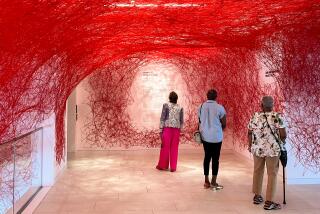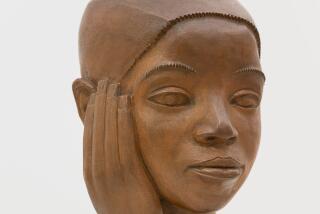A Chance to Set the Silver Standard
- Share via
Beautiful, functional and intrinsically valuable, silver seems to have it all. And with a recent gift of 430 pieces of 18th and early 19th century American silver from the estate of Miriam Maclaren Marble, the Huntington Library, Art Collections and Botanical Gardens suddenly has a lot more of it.
The donation--officially titled the Mrs. John Emerson Marble Collection of Early American Silver--is the premier private holding of its kind, so the gift instantly establishes the Huntington as an important repository of American silver, says Amy Meyers, curator of American art. Encompassing 34 kinds of pieces made by 160 silversmiths, the collection provides considerable insight into silver design and production, and illuminates the patronage, taste and social customs of the period.
About 160 examples--tea sets and tankards, commemorative cups and brandy warmers, cream pots and sugar tongs--go on view this weekend in a new permanent exhibition in the Virginia Steele Scott Gallery. Visitors will find everything from an ornate coffee pot with an eagle on top to a simple little pap boat, which might have inspired today’s commuter coffee cups. Designed to feed a child or a bedridden adult without spilling, it’s a cup with a covered spout.
The Marble collection transforms the Huntington’s holding of a few important pieces of American silver into a major resource. It would be a fabulous windfall in any circumstances, Meyers says, and it’s particularly meaningful because of its ties to the Huntington’s collection of British silver.
Marble, who lived in Pasadena and began buying silver sometime before 1920, collected in tandem with her friend Caroline Munro, whose gift of British silver constitutes the bulk of the Huntington’s 675-piece holding of that material. What’s more, Gregor Norman-Wilcox, then curator of decorative arts at the Los Angeles County Museum of History, Science and Art in Exposition Park, advised both women on their collections.
“Not only can we tell an extraordinary story about the history of British silver and American silver, but we can also bring these two collectors back together,” Meyers says. While celebrating the women’s friendship and artistic passion, the Huntington is also honoring their mentor, who was a leading scholar of decorative arts in Los Angeles in the early 20th century.
*
It isn’t clear how the relationship between the two women began, but their papers show they scouted potential acquisitions for each other while pursuing their individual interests, says Hope J. Spencer, an independent, Santa Barbara-based scholar who has written a soon-to-be-published book on the Marble collection.
Munro began giving British silver to the Huntington in 1953 and continued until her death in 1973, when the institution received the remainder of her collection as a bequest. Marble’s cache of silver remained in her family after her death in 1962. Since then, it has been on long-term loan to Stanford University, the Santa Barbara Museum of Art and the Huntington.
Other members of the Marble family have donated artworks to the Huntington over the years, so it seemed likely that the silver collection would end up there too. Marble’s grandson, Peter Emerson Marble, eventually decided the Huntington was the right place for her silver because it would be on permanent view as an American counterpart to Munro’s British silver. He made the gift in honor of his grandparents.
The sampling displayed in the Scott Gallery reveals the interests and collecting patterns of a woman who was born in 1876 in Red Wing, Minn., and educated at Stanford, where she met her future husband, John Emerson Marble. They were married in 1901 and settled in Pasadena. Apparently a collector at heart, Miriam Marble began buying Native American baskets on trips to the Southwest and then switched to early American silver. Her first purchase was an engraved tea caddy made by Philadelphia silversmith Daniel Dupuy Jr.
She cast a wide net and acquired a variety of objects made from the early 1700s through the antebellum period. In those days, fine silver was crafted in the East, as far west as Kentucky, but the most prized items were usually produced in the Northeast.
Marble focused on America’s most stylish centers of silver production--Pennsylvania, New York and Massachusetts--while buying examples from many other areas. A few works made their way to England before she retrieved them, but she made most of her purchases from families in the Pasadena area. As her collection grew, she developed a remarkable concentration of pre-1800 work, including a group of pieces from Massachusetts and 106 examples of early hollow ware.
*
Like fine art, silver can be studied in terms of stylistic evolution and technical development. But most silver objects are made to be used, if only ceremonially. What’s more, the material has intrinsic value. If family funds run short, the silver can be sold or traded; if Grandma’s teapot goes out of fashion, it can be melted down and given a new life. When the personalities and preferences of collectors are added to the mix, scholars and curators who want to tell a story about silver have a lot of options.
The Huntington chose to introduce Marble and place her collection in a social context. With the help of text and historic illustrations, visitors can see how specific pieces were used and learn about the role silver played in American history.
The display--near the entrance of the gallery--is the product of a team effort, Meyers says. Spencer provided expertise on the collection; Lee Vedder, a staff research associate in American art, wrote the wall text; and Gregg Bayne, exhibitions preparator, designed and constructed the installation.
The team consulted with curators at the Victoria & Albert Museum in London, which recently renovated and redesigned its silver galleries, and they examined silver exhibits at other institutions. After considering various ways to present the collection, Meyers and her colleagues let the objects suggest several themes. The point, she says, was to determine “a set of topics that would not only lend themselves to narratives about silver, but also highlight extraordinary pieces in the collection.”
An introductory section on the function, form and style of American silver leads an exhibit on the consumption of exotic beverages and features objects used to serve tea and coffee. A section on social drinking presents tankards and other containers for alcoholic beverages. The rites of passage section offers commemorative objects engraved with coats of arms, family crests, monograms and declarations that mark births, christenings, marriages, deaths and other occasions.
Next comes an explanation of silversmith training and practice. Another section presents a variety of cream pots, sugar tongs and spoons from the 18th and early 19th centuries.
Winding up the presentation is a panel on the professional and social status of silversmiths, who enjoyed the same prestige as bankers and often served their communities by holding civic or church positions and by participating in local politics. Finally, there are portraits by painter John Singleton Copley of two Boston silversmiths--Nathaniel Hurd (1730- 1777) and the celebrated patriot Paul Revere Jr. (1734-1818), both of whose works are represented in the Marble collection.
*
Important as the new installation of American silver may be to the Huntington, it is only the first phase of an extensive reinstallation and reconfiguration of the Scott Gallery, which got its start with a gift from the Virginia Steele Scott Foundation. While the Huntington is primarily known as a bastion of British art and culture, the 1979 Scott gift--50 American paintings, funds to build the gallery and the seed of an endowment--has become a catalyst for a significant collection of American fine and decorative arts.
In fact, says Meyers, the American holdings are now “bursting at the seams.” Thanks to a $130,000 grant from the Luce Foundation--which supports collections of American art that are “important but struggling, either young like Scott or overlooked,” Meyer says--the Scott collection is being reinterpreted, “starting from scratch.”
One goal is to get more of the bounty on display. The new MaryLou and George Boone Gallery now hosts the Huntington’s temporary shows, so the Scott Gallery’s temporary exhibition space is being converted to a permanent-collection showcase for American modern art and furnishings, including silver. It’s expected to open in June.
Meanwhile, a small room in the Scott Gallery that housed maintenance equipment is also being transformed into another gallery. It will open in September, when the entire project is scheduled for completion.
“We’ll use this little gallery for small focus shows, and to exhibit drawings, prints and photographs that we haven’t been able to share with the public,” Meyers says. “It will also be a great place to present new acquisitions,” she says, with a broad smile indicating that the silver collection is only the beginning.
More to Read
The biggest entertainment stories
Get our big stories about Hollywood, film, television, music, arts, culture and more right in your inbox as soon as they publish.
You may occasionally receive promotional content from the Los Angeles Times.










